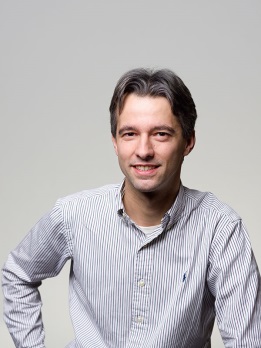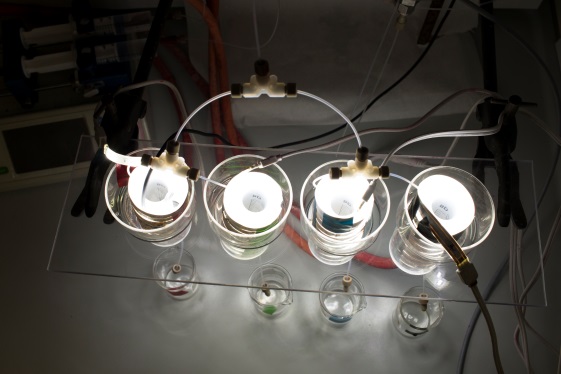24/09/2015
Dr. T. e as reaçÃĩes em fluxo na 39Š RASBQ
Jovem cientista belga virÃĄ pela primeira vez ao Brasil, onde espera estabelecer colaboraçÃĩes e parcerias com instituiçÃĩes locais
Timothy NoÃŦl ÃĐ uma estrela em ascensÃĢo na QuÃmica mundial. O belga de 33 anos, professor na Universidade de Tecnologia de Eindhoven, na Holanda, ÃĐ especialista em reaçÃĩes quÃmicas em fluxo. Ele tambÃĐm ÃĐ coordenador da rede Photo4Future, do Marie Curie Inovative Training, que tem o objetivo de superar limites de escala e aplicabilidade de reaçÃĩes fotoquÃmicas. E NoÃŦl ainda encontra tempo para colaborar como editor associado com o Journal of Flow Chemistry, criado em 2011 pela Flow Chemistry Society.
|
|

|
|
| Professor Timothy NoÃŦl: âAcredito firmemente que educaçÃĢo de qualidade ÃĐ um requisito para trazer prosperidade para uma naçÃĢo e superar problemas sociais e econÃīmicos. E provavelmente nÃĢo hÃĄ nada mais interessante para estudar do que ciÊncia e tecnologia
|
Dr T., como ÃĐ chamado em Eindhoven, virÃĄ ao Brasil, pela primeira vez, para participar da 39Š. ReuniÃĢo Anual da SBQ, a ser realizada entre 30 de maio e 2 de junho de 2016 em GoiÃĒnia. âSei que pesquisas muito interessantes sÃĢo realizadas no Brasil e espero poder estabelecer parcerias e colaboraçÃĩes para o mÃĐdio e longo prazoâ, disse ao Boletim da SBQ. AlÃĐm da conferÊncia, Dr. T. darÃĄ um minicurso sobre o tema.
Engenheiro quÃmico industrial formado em KaHo Sint-Lieven, em Ghent (BEL), Dr. T, concluiu seu doutorado na Universidade de Ghent, no LaboratÃģrio de SÃntese OrgÃĒnica e BioorgÃĒnica. Em seguida mudou-se para os Estados Unidos para fazer o pÃģs-doutorado em MIT, onde estudou as reaçÃĩes de fluxo contÃnuo.
|
|

|
|
|
ReaçÃĩes em fluxo contÃnuo sÃĢo uma das especialidades do Dr. T
|
NoÃŦl destaca a importÃĒncia da formaçÃĢo de novos cientistas e do investimento em educaçÃĢo e ciÊncias. âAcredito firmemente que educaçÃĢo de qualidade ÃĐ um requisito para trazer prosperidade para uma naçÃĢo e superar problemas sociais e econÃīmicos. E provavelmente nÃĢo hÃĄ nada mais interessante para estudar do que ciÊncia e tecnologiaâ, declarou.
Leia Ãntegra da entrevista exclusiva concedida pelo professor Timothy NoÃŦl ao Boletim da SBQ:
What will your lecture be about?
I will definitely talk about flow chemistry, which is one of our main expertises. More specifically, our group specializes in developing new continuous-flow protocols for important transformations in organic synthetic chemistry. We focus at the moment on visible light photoredox catalysis and CH activation chemistry. Both these methodologies are currently a hot topic in literature. Visible light photoredox catalysis has been recognized as a mild and selective way of small molecule activation. Actually, Brazil has a lot of sun which could be utilized to drive these reactions forward. The advantage of microreactors is that the reactions can be done superfast (seconds or minutes instead of days) and with very high selectivity. Furthermore, it allows one to scale up the chemistry substantially. CH activation is interesting as it provides means to make pharmaceuticals efficiently and from cheap starting materials. We have been able to accelerate this process to the minute range as well.
We will also give a short course on flow chemistry. Continuous-flow reactors have been increasingly used in synthetic organic chemistry to facilitate chemistries which are otherwise difficult to carry out. This includes gas-liquid reactions, photochemical transformations, chemistries utilizing hazardous compounds, extreme reaction conditions and multistep reaction sequences. While many chemists understand the chemistry behind flow chemistry really well, the engineering aspects of the field are less understood. This seems initially not to be a major hurdle, but a thorough understanding of the engineering principles behind the observations would allow one to get the maximum out of the technology. I hope that I can educate the participants about these engineering principles and show them in which occasions flow chemistry might make a difference for their applications.
Could you briefly describe your daily work, both on Eindhoven University of Technology and on Photo4Future?
I am currently a tenured assistant professor at Eindhoven University of Technology. Our mission is to facilitate challenging chemical transformations, e.g. CH activation and photochemistry, by developing innovative reactor designs. My group consists of 6 Ph.D. students and 2 postdoctoral researchers. Furthermore, I am involved in teaching âchemical reaction engineeringâ, âadvanced organic chemistryâ, âadvanced inorganic chemistryâ, and a practical course for first year chemical engineers.
I am also the coordinator of a Marie Curie Innovative Training Network âPhoto4Futureâ (www.photo4future.com). The network aims to overcome the current limitations towards the applicability and scalability of photochemical transformations. This will be achieved through a rational design of novel photocatalytic methodologies, improved catalytic systems and innovative photoreactors.
Further, I am an associate editor of Journal of Flow Chemistry, a specialized journal reporting flow chemistry in inorganic, organic, analytical and process chemistry in the academic research as well as in applied research and development in the pharmaceutical, agrochemical, fine-chemical, petro-chemical, fragrance industry.
How do you view the importance of universities and businesses working together to solve social-economic problems?
To make progress in continuous-flow chemistry, full support from the industry is crucial. Interest from the industry is typically fueled by the increased safety, the higher reaction selectivity and the overall efficiency of the chemical reaction. Such collaborative efforts are not only important from a funding perspective but industrial applications will facilitate the widespread use of this technology, reduce the overall cost, and stimulate innovations in real life examples. Examples which still require substantial collaborative research efforts are, e.g., (i) controlled scalability from lab to full production scale; (ii) efficient recycling of metal catalysts; (iii) safe use of hazardous reagents (e.g. diazonium salts, oxygen,âĶ).
Furthermore, it is my firm belief that an adequate education of young people is required to bring prosperity to a country and to overcome social-economic problems. One of the most interesting studies one can pursue in academia is probably science and technology. New technological advances are absolutely required to overcome current climate issues and to bring wealth to the people at an affordable price.
How to best engage youth into Sciences? How did you get into studying Chemistry?
Chemistry is at the fundament of life itself. The fundamental processes in our body can be only understood when one has adequate understanding of chemistry. This triggered my attention when I was young and it was one of the main reasons why I studied chemistry and chemical engineering. My passion for organic chemistry was drawn when I was in high school. The versatility of the different transformations along with beautiful mechanisms were like magic. I still remember that my high school teacher told me that I understood it better than he did. It seemed at that point that I had talent for it and so that one event always played a role when making my career moves. So I believe that an inspiring teacher is the best person to get young people to study chemistry.
However, we also have also a huge image problem. A lot of people believe that chemicals are in se dirty, which it is obviously not as you dig deeper in the matter. However, the public opinion needs to be altered and we need to come up with good PR strategies to make chemistry sexy again. For instance media should focus on the fantastic materials we can make nowadays, or the solar energy and chemical biology which benefits us all, instead of reporting on âchemicalâ bombs.
It is remarkable in fact how physics disciplines are sometimes reported in the media and appeals the public opinion., e.g. black holes, far galaxiesâĶ Most of the science behind physics is mathematics, spectroscopy,âĶ however, they have come up with smart ways to promote their field. So we can learn a great deal from them and we should also try to sell our field similarly and try to play with the imagination of the public. If we succeed, we will definitely attract more students!
What do you expect from your visit to Brazil for the SBQ Annual Meeting?
I hope to connect with the Brazilian chemists and chemical engineers. Some really interesting research is done in Brazil and I hope that we can establish some collaborations in the short and long term. In the coming months, I will try to figure out if there are any funding opportunities which would allow me to collaborate with Brazilian scientists. I am very much looking forward to coming to Brazil, it is actually my first time!
Artigos sugeridos
âA mild, one-pot Stadler-Ziegler synthesis of arylsulfides facilitated by photoredox catalysis in batch and continuous-flowâ, X. Wang, G. D. Cuny, T. NoÃŦl, Angew. Chem. Int. Ed. 2013, 52, 7860-7864.
âA mild and fast photocatalytic trifluoromethylation of thiols in batch and continuous-flowâ, N. J. W. Straathof, B. J. P. Tegelbeckers, V. Hessel, X. Wang, T. NoÃŦl, Chem. Sci. 2014, 5, 4768-4773.
âAerobic CâH olefination of indoles via a cross-dehydrogenative coupling in continuous flowâ, H. P. L. Gemoets, V. Hessel, T. NoÃŦl, Org. Lett. 2014, 16, 5800-5803.
âMetal-free photocatalytic aerobic oxidation of thiols to disulfides in batch and continuous-flowâ, A. Talla, B. Driessen, N. J. W. Straathof, L.-G. Milroy, L. Brunsveld, V. Hessel, X. Wang, T. NoÃŦl, Adv. Synth. Catal. 2015, 357, 2180-2186.
âA convenient numbering-up strategy for the scale-up of gas-liquid photoredox catalysis in flowâ, Y. Su, K. Kuijpers, V. Hessel, T. NoÃŦl, Reaction Chemistry & Engineering, submitted.
Para saber mais:
Universidade de Tecnologia de Eindhoven
Photo4Future
Flow Chemistry Society
A 39Š ReuniÃĢo Anual da SBQ serÃĄ no Centro de ConvençÃĩes de GoiÃĒnia, de 30 de maio a 2 de junho de 2016.
Curta a pÃĄgina da RASBQ e acompanhe as novidades do evento! Convide tambÃĐm seus amigos. Juntos, faremos uma grande reuniÃĢo anual!
Texto: Mario Henrique Viana (Assessor de imprensa da SBQ)
|